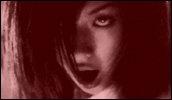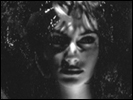The Ring
- Year
- 1997
- Original title
- Ringu
- Japanese title
- リング
- Director
- Cast
- Running time
- 95 minutes
- Published
- 20 March 2001



by Jasper Sharp
As a rule of thumb, Japanese horrors have traditionally either been grounded in the folklore and legend of ghost stories such as Masaki Kobayashi's portmanteau of Lafcadio Hearn short stories, Kwaidan (Kaidan, 1964) or Satsuo Yamamoto's The Bride From Hell (Kaidan Botandoro, 1968), or merely oriental riffs on transplanted Western gothic staples, such as Lake of Dracula (Chi o Suu Me, 1971 - Michio Yamamoto) or The Ghost of the Hunchback (Kaidan Semushi Otoko, 1965 - Hajime Sato).
Ring takes a leaf from the sanitised teen-pitched US genre revival spearheaded by Wes Craven's Scream cycle in locating its story in a contemporary setting, but adopts a considerably more sombre and narrative-driven approach to the material, marrying the urban mythological basis of The Blair Witch Project (1999) with the vengeful ghost scenario so rooted in the Japanese chiller.
Adapted from the popular novel written by Koji Suzuki, Nakata's high-concept popcorn movie was a box-office smash when released on a double bill with Joji Iida's Spiral (Rasen, 1998, another Suzuki adaptation) in February of 1998, rapidly becoming the top grossing horror of all time at the domestic box office and setting in motion a torrent of terrors that included Shikoku and Tomie.
The story centres around a video, which once seen causes the viewer to die mysteriously within the space of a week. An investigation into the deaths of two teenage girls by TV journalist Reiko (Matsushima) and her ex-husband Ryuji (Sanada, the former 1970s action hero and a frequent collaborator with Sonny Chiba) unearths the malefactor, the vindictive ghost of Sadako Yamamura, a child psychic pitched down a well thirty years prior, now manifesting herself through means of the aforementioned videotape. To say any more would reveal far too much of a script that leads Reiko through a succession of different locales to the heart of the mystery.
With nothing in the way of gore or nudity and an unobtrusively even editing style, Ring evokes the innate uncanniness of its central premise over the short, sharp shocks one usually associates with modern horrors, and sports some incredibly effective moments, all laid down to an electronic soundtrack of onomatopoeic groans and whirs. You can feel the goosebumps during Sadako's manifestation through the cathode ray tube. Given the sheer artificiality of the film's central concept, not to mention the odd hole in the convoluted and occasionally lackadaisical plotting, it's all down to Nakata's subtle handling of such impressive set pieces that the film works as well as it does.
With Ring a sweeping success across Asia and later critically well received upon its European release, Nakata was back to direct the inevitable Ring 2, released the following year. Neatly picking up from where the first film finished off and adopting pretty much the same formula and approach, the sequel does a fairly good job of continuing the story in an inventive enough fashion. Though neither markedly better or worse than the original, it added little new to the proceedings, and Nakata sensibly stepped aside from the franchise to helm the love story Sleeping Bride (Garasu no No). After a spin-off TV series (Ring: Saishusho), Norio Tsuruta took the helm of Ring Ø: Birthday (2000), but by this time the formula was getting decidedly stale.
Ring's remake rights were rapidly snapped up by Dream Works in the US, with producer Roy Lee subsequently acquiring the remake rights for a whole host of "unknown" hits from a number of Asian countries. Either unable or unwilling to compete against Hollywood bombastic market practices, the producers of the Japanese original of the Ring have literally given up the ghost - on Sunday 11th August 2002, during the Japanese public holiday of O-Bon, the Festival of the Dead, a symbolic funeral for Sadako, the leering apparition at the heart of the series, was held in Tokyo's Harajuku district.